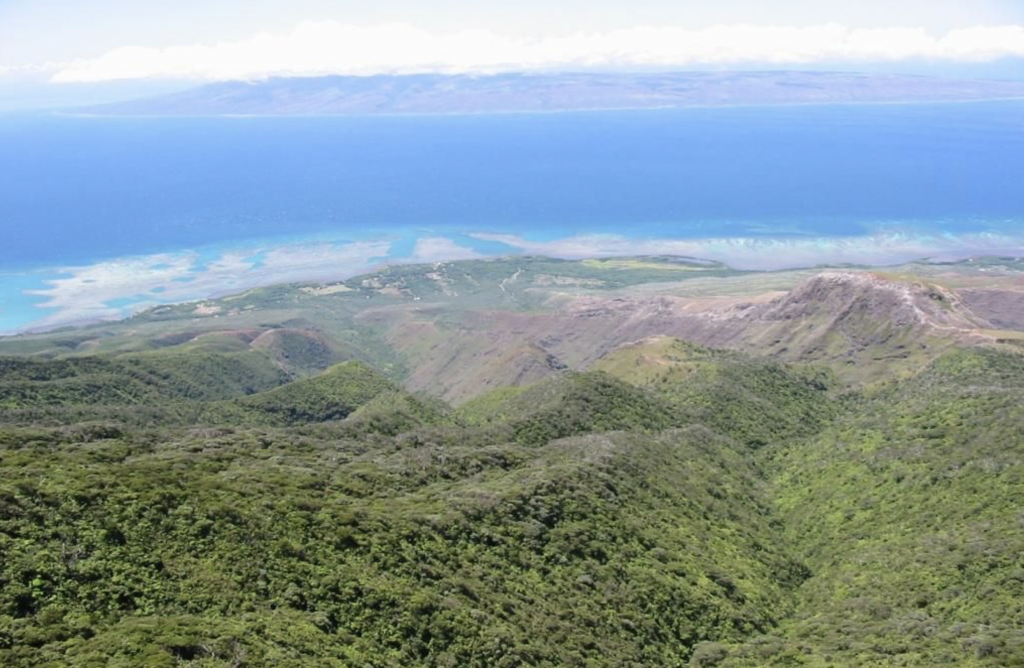Moloka’i Forests To Be Protected From Wildfires and Erosion
Forests on the southern slopes of Moloka‘i are about to receive additional protection from threats like wildfires, erosion and flooding thanks to a new award from the National Fish and Wildlife Foundation. The foundation has awarded over $1.8 million to the DLNR to address threats using proven tools such as fencing and removing hooved animals, as well as creating firebreaks.
The results will include clearer ocean waters, vibrant reefs, restored plants and trees, and fewer disruptions along the islands’ main road, Highway 450. State funding that served as a match for the grant is part of a larger Watershed Initiative that is directing an additional $2 million of State Capital Improvement Project and operating funds to protect Molokai’s forests and employ Molokaʻi residents.
“Watershed CIP funds authorized by the State Legislature provided most of the match needed to apply for this grant. As a result, we’re able to invest in the community by providing much needed jobs and protection of our forests and other natural resources,” said Senator J. Kalani English, who represents Hāna, East and Upcountry Maui, Molokaʻi and Lānaʻi.
“I’m delighted that this State funding has been able to attract more Federal and private funding that will create more jobs on Moloka‘i while helping preserve our forests and reefs,” said Representative Lynn DeCoite, who represents Molokaʻi, Lānaʻi, and East Maui.
Some Federal and foundation funds are available only when a matching investment can be demonstrated. Since 2013, State Watershed Initiative funds have brought in over $36 million in Federal, County, and private funds for forest protection projects statewide. “Combined funding creates jobs and benefits nature. It’s a win-win,” said Suzanne Case, DLNR Chairperson.
“The National Coastal Resilience Fund supports projects that restore natural systems in order to reduce risks to local communities and also enhance habitat for fish and wildlife,” said Erika Feller, Director of Coastal and Marine Conservation for NFWF. “We are excited to support DLNR’s work to restore native forests, which will help to reduce risks of flooding, landslides, and fire to communities on Molokaʻi, and will lead to healthier habitat for native species.”
The East Molokaʻi Watershed Partnership, led by The Nature Conservancy (TNC), involves DLNR and other agencies, landowners, and community organizations working to develop a landscape-level management plan to address problems across the south slope, where dirt washes down to the ocean and clogs fishponds, kills corals which need sunlight to grow, and feeds invasive algae that smothers the reef. This funding enables the partners to continue protecting Molokai’s remaining native forests that hold the soil and absorb rainwater, and where possible, restore areas converted to bare dirt by wildfires, and hooved animals.
“Each budget session our Maui County Council allocates significantly to forest watershed protection efforts countywide,” said Council Vice Chair Keani Rawlins-Fernandez, who serves as the Economic Development and Budget Committee Chair, “and being from Molokai, where subsistence is our way of life, funding resource management is highly prioritized.”
“Moloka’i depends on our natural resources to sustain our lifestyle. Protecting our watershed and restoring our forests protect our reefs. Taking care of Mauka takes care of Makai,” said Stacy Crivello, Molokai Community Liaison for Mayor Michael Victorino, County of Maui.
“The ʻōlelo no‘eau (Hawaiian proverb) ‘Inā e lepo ke kumu wai, e hō‘ea ana ka lepo i kai’ means ‘If the source of the water is dirty, muddy water will travel to the sea,’” says Ulalia Woodside, Director of The Nature Conservancy, Hawaiʻi chapter. “By restoring forests, we protect our water source, prevent erosion and provide jobs that support the people of Molokaʻi and the nature that sustains them.”

A view of Molokai’s Kawela ahupua’a (gulch) looking south. This grant will fund the forest restoration of the middle and lower parts of the gulch which are largely barren due to past fires and damage from hooved animals. Credit: The Nature Conservancy.

The Nature Conservancy staff building fences on the south slope of Moloka‘i. This project will create and sustain jobs for Moloka‘i residents. Credit: The Nature Conservancy.

DLNR’s staff building fences on Moloka‘i. This project will create and sustain jobs for Moloka‘i residents. Credit: DLNR.

A firebreak road successfully stopping a fire from spreading to the left (eastward) on Moloka’i’s south shore. Wildfires are common along Molokai’s south shore, including a fire in 1998 that burned over 15,000 acres. This project will fund improvements to access roads that can serve as firebreaks–a major tool in halting the spread of wildfires that threaten life, property, as well as the native forest. Credit: The Nature Conservancy.












